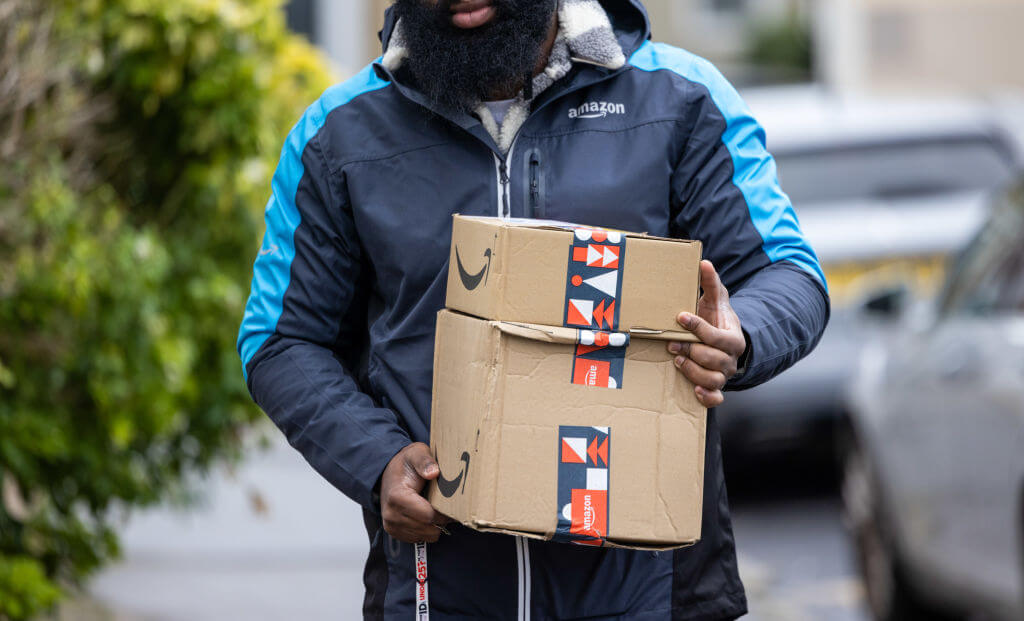Our Best Tips to Save on Amazon Prime Day
We’ve put together some tips for saving on Amazon Prime Day to ensure you get the best prices. Read on for our best advice on bagging the best bargains.

- Get a Prime Membership
- Decide which categories you’re interested in
- Create a shopping list
- early prime day deals
- Tune in early
- Check for lightning deals
- Use Price Comparison Sites
- Research new products
- Beware no-name brands
- Stay up to date with the latest info
- Download the Amazon App
- Get some help from Alexa
- Watch for first-party deals
- Look out for rival promotions

Nathan Walters
Disclaimer
When you click a link to our discount code page, we may receive a small commission if you purchase something from a retailer's website.
Amazon's Prime Day is a big event full of sales held every summer with hours of deals. Created to rival Black Friday in terms of deals, Prime Day has quickly become a go-to for significant savings on the wide range of goods the world-famous company sells.
If you want to make the most of the deals the famed event offers, we’ve put together some tips for saving on Amazon Prime Day to ensure you get the best prices. Read on for our best advice on bagging the best bargains.
Get a Prime Membership
Having an Amazon Prime subscription is essential to saving on Prime Day deals. Not only do you get free delivery, but many customers miss exclusive discounts because they forget that the deals are only for Prime members. Thankfully, it’s easy to avoid making this mistake with a quick visit to your Amazon account.
If you aren’t a Prime member, we highly recommend using the free 30-day trial to save on membership fees. Start your trial in the run-up to the event (once the dates have been confirmed), and you’re good to go. You can always cancel once Prime Day is over if you want to keep it that way.
Students can get 6 months free at the start of their membership, followed by a discounted price of only £4.49 a month after the free trial ends. If you’re in full-time education, this is a great way to spend as little as possible whilst getting involved in Prime Day sales.
Decide which categories you’re interested in
As one of Amazon’s well-known taglines says, their online range includes “everything from A to Z.” You can shop a huge number of categories, including electronics, books, smart tech, films, TV, music, games, home and garden items, toys, fashion, sports gear, musical instruments, healthy and beauty products, and even food and groceries.
Amazon lets you filter results by categories using the search bar and a series of checkboxes on the left-hand side of results pages. Decide what kind of products you’re looking for ahead of time, and using these categories to narrow down your search on the day will help you see only the relevant offers.

Create a shopping list
When Prime Day rolls around, you’ll see hundreds of thousands of offers. According to Amazon’s stats, more than 2 million deals went live for Prime Day 2021. If that sounds like a lot to sort through, you’d do well to start thinking about what you want to buy before the event begins. Add items you wish to purchase to your wishlist or basket or write down specific products to look up on the day.
We advise using your basket or wishlist, as this will also let you receive notifications about deals on these specific products. Knowing what you’re after will prevent you from being drawn in by the multitude of other offers out there. Keeping to your budget will be easier without the temptation to buy something you don’t need, meaning the discounts you pick up will mean genuine savings in your wallet.
early prime day deals
Although Prime Day began as a single 24-hour day of deals, it has now expanded to a 48-hour sale. Amazon has also started running separate Early Access sales to give customers additional chances to bag savings. In 2022, after the summer Prime Day event, customers could return on October 11th & 12th for what Amazon dubbed ‘Prime Day Early Access’, which promised deals ahead of the holiday shopping period.
Early Access events are similar to Prime Day. The exact dates change each year, but you can expect them before the start of the holiday season, and they offer similar discounts on the same products. You’ll see up to 50% off selected products, plus multibuy deals, best sellers, and offers on streaming service subscriptions.
Don’t get Early Access confused with the deals Amazon tends to start running offers ahead of the main Prime Day event (which people often do). According to Amazon, Early Access is a separate event, usually in Autumn, that gives customers a second chance to snap up goods at low prices before the holiday season. When most people say ‘early offers’, they tend to think of the promotions that appear ahead of Prime Day, which leads us neatly on to our next tip...

Tune in early
As we mentioned, deals will start to pop up before Prime Day's actual date to entice customers before the main sale kicks off. Expect to see deals appearing as far as two weeks ahead of the date. Generally, deals tend to get better as the main sale approaches, so you’ll need to decide whether a good offer should be bought now or if a better one might come up on the day itself.
Deciding whether a deal is worth grabbing works on a case-by-case basis. First, has that product been on sale for less before? If so, it will likely happen again soon. It’s also worth checking how long an offer lasts. Generally, more limited-time offers are more generous, which is why they aren’t around for long.
Check for lightning deals
Prime Day features a range of different promotions outside of the main sale, such as a ‘Deals of the Day’ section which is updated daily with 24-hour offers, flash sales, and so-called ‘Lightning Deals’ which are limited-time deals exclusive to Amazon Prime members. Both flash sales & lightning deals will bring savings for a short time, so you’ll need to keep your ear to the ground if you don’t want to miss them.
Flash sales tend to be offered in categories, whereas lightning deals are often specific to individual products. For instance, a flash sale on electronics might give you an extra 20% off selected devices for a few hours only, whilst a lightning deal on selected Kindle e-readers a new echo device, fire tablets, or big-ticket items may help you save up to 50% off that are only around for the next hour or two.
Use Price Comparison Sites
An essential tip for saving on Prime Day and similar seasonal sales is to be careful when you see a huge discounted deal that seems too good to be true, even from a named brand. Retailers have been found to inflate prices on products before a big sale, so the price difference looks larger. Prices are sometimes similar to other points in the year, so don't give in to FOMO and impulse purchases because there is a good chance it will be on sale again.
To recognise if the deal you're getting is authentic, use price comparison sites such as camelcamelcamel, PriceSpy or PriceRunner. These valuable and free-to-use sites track prices over a year and tell you if you're getting a great deal, or if an item was increased just before the sale to look like a better offer.

Research new products
Knowing if any new products are launching for or around Prime Day is also handy. Whenever new products launch, older products of the same kind tend to decrease in price. This is especially true for tech goods - the iPhone 14 will become cheaper when the iPhone 15 is released, for example - but it’s also true in other categories such as fashion. Think of the savings offered on last season’s fashion.
When new products are launched, you may see promotions to decrease the latest models' launch price. However, this isn’t guaranteed, and products are often at their most expensive just after they launch. Even if discounts are available, buying the latest device can set you back a serious sum.
Your best bet for saving in the wake of newly launched products is to opt for older models, which are often heavily discounted once they become less recent. The older the model you choose, the better. For instance, if the iPhone 15 is released tomorrow, you could expect decent savings on the iPhone 14s compared to before the launch, but if you wanted to cash in on the most significant price drops, looking at the likes of the iPhone 13 or even iPhone 12 might reveal some brilliant bargains.
Beware no-name brands
As an extensive online marketplace, Amazon sells products from many of the world’s biggest brands and third-party sellers. However, you’ll also find plenty of lesser-known brands on the platform and mysterious unnamed brands significantly cheaper than branded alternatives.
Although these lower prices might be tempting, especially with an exceptionally generous Prime Day deal, you should be cautious of no-name brand products. Choosing a brand means you have an assurance of quality and a level of accountability. When picking a brand you’ve not heard of, make sure you do a quick internet search to find out how other customers have reviewed those products.
With no-name brands, you have no assurance that you’re buying a quality product, so choosing these products can be a gamble. We advise checking the reviews of any products from brands you don’t recognise and the seller profile. An absence of reviews (or many bad ones) is a surefire sign that your money is best spent elsewhere.

Stay up to date with the latest info
Prime Day will see many deals come and go, and with early access sales, pre-event offers, lightning deals, and flash sales, a lot can change in the blink of an eye. In some cases, offers should be snapped up while they’re still around, whereas in others, you’re likely to see better discounts if you wait until later in the event.
Knowing which way to play it can be tricky, so it pays to stay updated with the latest information on Prime Day by signing up to deal alerts. What constitutes a good deal also depends on the type of product you’re looking for (which is where it pays to have expert advice on hand).
As one of the biggest retail events of the year, Prime Day attracts extensive coverage from various publications. Experts and offer aficionados scrutinise every offer long before the event starts. Tuning in to a trusted source and keeping abreast of what they report back will make it easier to stay in the know.
You should be able to find out how much current deals can save you, how long they’ll last, and whether there are likely to be better deals coming up soon. Use these insights to decide when to swoop in early and bag bargains that won’t be around for long and when to wait until a later date for more significant savings.
Download the Amazon App
Downloading the Amazon App will allow you to monitor the best deals closely. You can add deals to your watch list through the app, meaning you’ll get notifications when similar savings are available. You can also see all the deals that are currently available. The most useful feature, though, is the deals notification setting.
Turn on deals notification, and you’ll be sent a notification whenever a new offer goes live. This is especially handy for catching those limited-time lightning deals while on the go. Opt to receive push notifications to make these heads-up messages easiest to notice. The Amazon App is free to download on Android and Apple, and you just need to sign in with your Amazon account to get started.

Get some help from Alexa
Unsurprisingly, if you own one of Amazon’s own-brand smart devices, you can ask Alexa to help you stay up to date with deals. In the same way that setting up push notifications on the Amazon app will keep you in the loop with new offers, you can ask Alexa to “remind you when Prime Day starts.”
You can also add items to your shopping cart, save them for later, or add them to a wish list. When the deals notification setting is on, you’ll get a warning 24 hours before deals go live on those items so you know when to expect savings. You’ll see a yellow light on the ring of your speaker when this feature is active. I'm not sure you’ll remember to check back in 24 hours. Not a problem! Ask Alexa to order the item for you tomorrow so you don’t miss out on the deal.
Watch for first-party deals
It’ll come as no surprise that Amazon’s own sales event is one of the best times to save on its own-brand technology, including its e-readers, streaming devices and smart tech. Customers know it too - in 2019, Amazon set record sales for its own-brand gadgets, particularly with its Echo Dot smart speakers & Fire TV Stick streaming devices.
So much can you save on Amazon-branded devices on Prime Day? We tend to see anywhere up to 60% off devices for Prime Day. We saw 50% off Amazon Fire Sticks in 2021, and in the October 2022 event, 4th Generation Amazon Echo Dot smart speakers went on sale at their lowest-ever price of £19.99.

Look out for rival promotions
Given the immense popularity of successive Prime Days, many retailers have started running their promotions around the same time of year to get in on the action. If you see a deal you want to make the most of from Amazon. It’s worth checking if you can find that product at another retailer to ensure you save as much as possible.
Retailers like Currys and Appliances Direct frequently run tech sales, and their price match guarantee means they’ll meet prices even if they’re part of promotions like Prime Day. Using price match schemes can mean you net the exact discount and the benefit of added extras that only competing retailers offer, such as freebies, bundle deals, or better warranties.
Now you know how to get the most out of Prime Day! With our advice and a little preparation, you can grab all the new products your heart desires without breaking your budget and make the next Prime Day a day to remember. For the latest Amazon Prime deals and offers, head to our Amazon discount page or our best Prime Day Deals page.
Recent updates
I’m Harry, the tech editor, and I started working at MyVoucherCodes in March 2022. When I’m not writing about retailers, I spend my time listening to music and podcasts, playing guitar in a band and writing music reviews. I’m also a fan of long walks, reading new books, kicking back in front of the Xbox and discovering new places.
- Nathan WaltersTech & Savings Editor